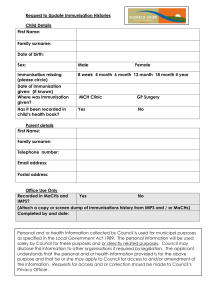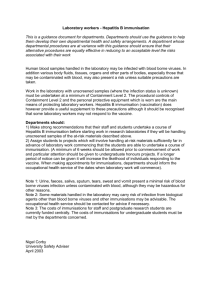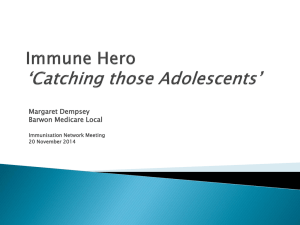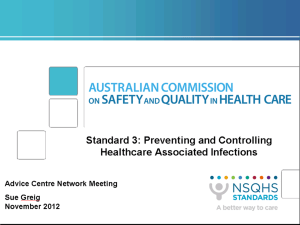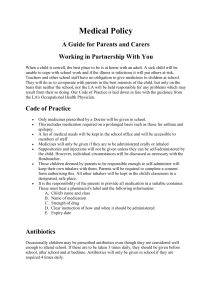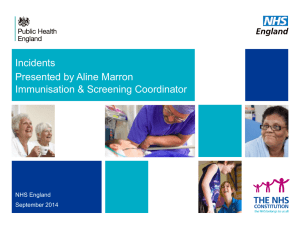Report on Childhood Immunisations in Harrow
advertisement
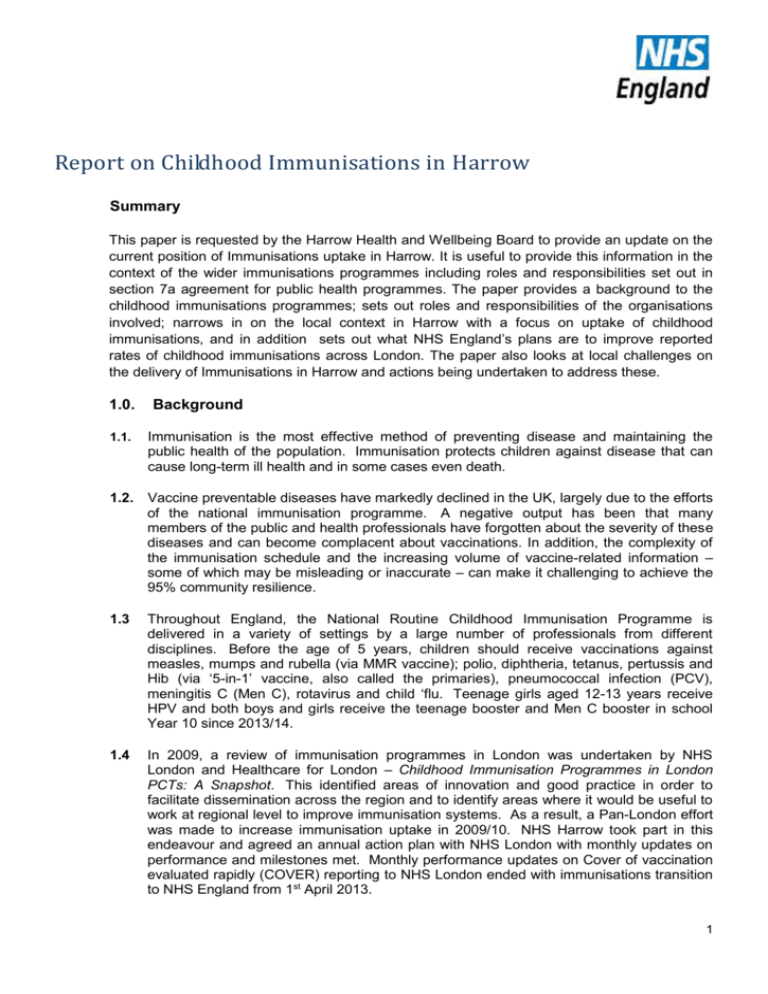
Report on Childhood Immunisations in Harrow Summary This paper is requested by the Harrow Health and Wellbeing Board to provide an update on the current position of Immunisations uptake in Harrow. It is useful to provide this information in the context of the wider immunisations programmes including roles and responsibilities set out in section 7a agreement for public health programmes. The paper provides a background to the childhood immunisations programmes; sets out roles and responsibilities of the organisations involved; narrows in on the local context in Harrow with a focus on uptake of childhood immunisations, and in addition sets out what NHS England’s plans are to improve reported rates of childhood immunisations across London. The paper also looks at local challenges on the delivery of Immunisations in Harrow and actions being undertaken to address these. 1.0. 1.1. Background Immunisation is the most effective method of preventing disease and maintaining the public health of the population. Immunisation protects children against disease that can cause long-term ill health and in some cases even death. 1.2. Vaccine preventable diseases have markedly declined in the UK, largely due to the efforts of the national immunisation programme. A negative output has been that many members of the public and health professionals have forgotten about the severity of these diseases and can become complacent about vaccinations. In addition, the complexity of the immunisation schedule and the increasing volume of vaccine-related information – some of which may be misleading or inaccurate – can make it challenging to achieve the 95% community resilience. 1.3 Throughout England, the National Routine Childhood Immunisation Programme is delivered in a variety of settings by a large number of professionals from different disciplines. Before the age of 5 years, children should receive vaccinations against measles, mumps and rubella (via MMR vaccine); polio, diphtheria, tetanus, pertussis and Hib (via ‘5-in-1’ vaccine, also called the primaries), pneumococcal infection (PCV), meningitis C (Men C), rotavirus and child ‘flu. Teenage girls aged 12-13 years receive HPV and both boys and girls receive the teenage booster and Men C booster in school Year 10 since 2013/14. 1.4 In 2009, a review of immunisation programmes in London was undertaken by NHS London and Healthcare for London – Childhood Immunisation Programmes in London PCTs: A Snapshot. This identified areas of innovation and good practice in order to facilitate dissemination across the region and to identify areas where it would be useful to work at regional level to improve immunisation systems. As a result, a Pan-London effort was made to increase immunisation uptake in 2009/10. NHS Harrow took part in this endeavour and agreed an annual action plan with NHS London with monthly updates on performance and milestones met. Monthly performance updates on Cover of vaccination evaluated rapidly (COVER) reporting to NHS London ended with immunisations transition to NHS England from 1st April 2013. 1 1.5 2.0. The Cover of vaccination evaluated rapidly (COVER) programme evaluates childhood immunisation in United Kingdom (UK).Public Health England (PHE) in collaboration with the National Public Health Service for Wales, CDSC Northern Ireland and Health Protection Scotland, collates UK immunisation coverage data from child health systems for children aged one, two and five years of age. This information is promptly fed back to local level, creating the opportunity to improve coverage and to detect changes in vaccine coverage quickly. Roles and Responsibilities 2.1 Since April 1st 2013, a number of public health functions are the responsibility of NHS England (NHSE) under Section 7a of the Health & Social Care Act 2012. These comprise screening, immunisations, Health in the Justice System (i.e. prisons, Sexual Assault Centres, places of detention) and military health. 2.2 The responsibility for commissioning immunisation programmes for London is the remit of NHS England (London) Public Health, Health in the Justice System and Military Health team. This team comprises of a roles with a London wide remit that work closely with immunisation commissioners situated within the 3 patch teams: North Central &East London, North West London and South London. The team consists of the Head of Early Years, Immunisations & Military Health, supported by Public Health England embedded staff; The Principal Advisor for Early Years Commissioning, Immunisation & Vaccinations; these personnel/posts provide accountability and leadership for the commissioning of the programmes and system leadership. The North West London patch area has a Lead for Screening & Immunisations and a small team of screening and immunisation commissioners. 2.3 The new arrangements for commissioning immunisations and vaccinations provides opportunities to improve uptake of immunisations. NHS England plans to utilise these opportunities to improve immunisation coverage in London. However, it is widely acknowledged that partnership working across multiple agencies is the only way in which sustainable improvements can be achieved. For an outline of roles and responsibilities of the different organisations, please refer to Appendix 1. 3.0. Childhood Immunisation Rates in Harrow 3.1 In London, immunisation uptake rates remain below the 95% levels required to achieve community resilience. Reasons for the low coverage include: the increasing birth rate in London which results in a growing 0-5 population and puts pressure on existing resources such as GP practices London’s high population mobility difficulties in data collection particularly as there is no real incentive for GPs to send data for Cohort of Vaccination Evaluated Rapidly (COVER) statistics large numbers of deprived or vulnerable groups. 3.1 Despite these challenges, Harrow has however; consistently achieved the required 95% uptake for community resilience for children aged 1. 2 3.2 Figures 1- 6 below illustrate immunisation uptake rates for Harrow. Figure 1. COVER rates (primaries) for Age 1 in Harrow for the period 2009-2014 Source: PHE (2014 Figure 1 illustrates the quarterly COVER statistics for the uptake of primaries for the age 1 cohort in Harrow. It shows a non significant decline of 2% from 95.5% in 2013/14 Q1 to 93.5% in 2013/14 Q2. Q3 and Q4 2013/14 rates increased again to the WHO recommended 95% uptake for achieving community resilience. Uptake rates for DtaP/IPV/Hib at 1 year for Harrow have consistently been above the London Average and equal and/or slightly above the England Average. Figures 2, 3 and 4 depict the COVER rates for the two boosters – PCV, Hib/MenC and MMR – for the age 2 cohorts. Vaccine uptake in Harrow varies considerably between quarters but has remained above the London Average.Fluctuations in vaccine uptake strongly suggest problems with the quality of immunisation data leading to inaccurate reporting in some quarters. Figure 2. COVER rates( Hib/MenC) for Age 2 cohort in Harrow for the period 2009-2014 Source: PHE (2014 3 Figure 3. COVER rates( PCV )) for Age 2 cohort in Harrow for the period 2009-2014 Source: PHE (2014 Figure 4. COVER rates( MMR) for Age 2 cohort in Harrow for the period 2009-2014 4 Source: PHE (2014 Figures 5 and 6 demonstrate the uptake for 2nd dose of MMR and pre-school booster rates. Similar to the general pattern across London where coverage rates decrease as age increases. Harrow’s age 5 COVER rates for MMR are approximately 4-5% lower than the age 2 cohort rates. At 86% Harrow rates of MMR are significantly higher than the London average of 80%. However, this decrease in coverage rates at age 5 is affected by data information systems not capturing movements in population and also reflects inadequacies in call/recall systems to bring children in for the remaining vaccinations on the Routine Childhood Immunisations Schedule. Pre-school booster rates for age 5 in Harrow are averagely similar or slightly lower as the uptake rates for the 2nd dose of MMR for the same cohort of children but considerably higher than Londonaverages.This indicates that for the missing numbers of children, work is needed to improvepatient management systems e.g. call/recall systems in GP Practices, reminding parents/guardians to bring their children to complete their immunisation schedule for example: checking status at every contact point with the child, robust call/recall systems in primary care that are timed to deliver the vaccinations in accordance to the immunisation schedule and a failsafe of CHIS operating a call/recall system to make appointments for COVER cohorts (known as defaulter process or active patient management). Figure 7 consists of Quarterly tabulated forms of COVER rates (%) for Harrow compared to other boroughs of North West London for 2013- 2014. Harrow’s rates are similar to those of its neighbouring outer North West London boroughsi.e. Brent and Hillingdon and higher in percentage uptake in six vital signs indicators when compared to the Inner North West London Boroughs. 5 Figure 5. COVER rates( MMR) for Age 5 cohort in Harrow for the period 2009-2014 Source: PHE (2014 Figure 6. COVER rates( pre-school booster) for Age 5 cohort in Wandsworth for the period 2009-2014 Source: PHE (2014 6 Figure7. Tables comparing COVER rates for Harrow with other North West London Boroughs (Source: PHE, North West London, 2014) Immunisation rate for children aged 2 who have been immunised for measles, mumps and rubella (MMR) (MMR) Immunisation rate for children Immunisation rate for children Immunisation rate for children Immunisations aged 1 who have been aged 2 who have been aged 2 who have been immunised for Diphtheria, immunised for Pneumococcal immunised for Haemophilus Tetanus, Polio, Pertussis, infection (PCV) - (PCV influenza type b (Hib), Diphtheria, Tetanus, Polio, Haemophilus influenza type b booster) meningitis C (MenC) - Pertussis (DTaP/IPV) - pre- Q1 1314 Q2 1314 Q3 1314 Q4 1314 (Hib/MenC) Q1 Q2 1314 1314 Q3 1314 Q4 1314 Q1 1314 Q2 1314 Q3 1314 Q4 1314 school booster Q1 Q2 Q3 1314 1314 1314 Q4 1314 Q1 1314 Q2 1314 Q3 1314 Q4 1314 PCT Name Brent Teaching PCT Westminster PCT Ealing PCT Hammersmith&Fulha m PCT Harrow PCT Hillingdon PCT Hounslow PCT Kensington & Chelsea PCT London (Hib) - (DTaP/IPV/Hib)- 3Doses Q1 Q2 Q3 Q4 1314 1314 1314 1314 Immunisation rate for Immunisation rate for children aged 5 who have been immunised for measles, mumps and rubella (MMR2) 2013/14 Q1- Q4 children aged 5 who have been immunised for 94.2 N.A. 93.6 94.3 77.6 94.4 93.1 79.8 94.4 91.5 78.1 93.5 90.5 N.A. 87.6 90.1 76.2 86.3 88.3 76.0 88.2 87.9 75.7 88.1 91.7 N.A. 88.7 91.1 76.7 87.9 90.2 75.8 89.7 88.7 76.8 89.1 90.4 N.A. 88.3 90.0 76.7 88.0 88.6 77.4 88.3 86.8 78.3 88.8 84.8 N.A. 85.2 82.3 61.2 84.8 81.5 59.6 84.1 81.8 63.5 83.8 85.7 N.A. 83.8 83.5 59.3 84.1 81.4 58.2 83.5 83.0 61.9 84.1 N.A. 95.5 95.8 91.0 78.9 93.5 94.6 90.5 79.2 95.5 92.1 91.7 76.2 95.9 94.1 90.5 N.A. 90.5 92.1 87.1 74.5 90.0 92.5 87.1 81.8 89.2 89.9 83.4 78.1 91.0 87.5 86.4 N.A. 91.9 91.8 89.2 73.6 91.2 93.0 89.0 82.6 89.4 90.8 85.3 80.2 91.8 89.2 87.6 N.A. 91.2 92.4 87.7 74.2 90.7 93.1 89.9 81.3 89.6 90.6 85.8 81.8 91.8 88.3 86.1 N.A. 86.7 91.1 91.6 68.7 82.9 91.5 71.5 27.9 85.1 88.3 92.0 31.3 86.8 89.4 72.6 N.A. 88.2 88.9 70.9 69.7 83.5 91.5 74.1 73.4 86.8 88.3 77.4 72.0 87.6 89.8 73.8 N.A. 90.1 79.6 89.3 74.0 89.3 78.8 89.1 N.A. 87.3 74.5 86.4 73.5 86.6 78.4 86.3 N.A. 87.9 73.6 86.9 72.1 86.9 77.7 86.5 N.A. 87.5 74.5 87.0 79.6 87.3 82.2 87.2 N.A. 80.5 64.0 78.8 57.0 78.3 57.9 78.0 N.A. 81.2 65.5 80.2 58.9 80.1 63.3 80.0 7 4.0. Improving Immunisation Coverage: Challenges and Initiatives There is a general pattern across London that coverage rates decrease as age increase. Possible reasons for low vaccine uptake rates include: 4.1 Data information systems not capturing movements in population (i.e. transfers in and movers out of borough) 4.1.1 Data flows and information management has the biggest impact upon COVER rate. Production of COVER rates is the responsibility of the Child Health Information system (CHIS) providers and the rates reflect how good the information is on the CHIS. However, in Harrow, Ealing ICO (CHIS) has not been involved in producing COVER reports since 2010. There has been a PCT historical arrangement between Brent and Harrow PCTs that GP Immunisations data is reported via an Internal GP reporting Portal. The Brent & Harrow GP reporting Portal has now been decommissioned and first quarter (2014-15) COVER data will now be reported via the Ealing ICO-Harrow CHIS. 4.1.2 Therefore, The Harrow Child Health Information Team will have to report accurate and complete data and this is dependent upon good flows of data between GP systems and CHIS and also requires that CHIS is regularly updated with movers in and transfers out (i.e. population mobility). Immunisation statistics depend on accurate assessment of the numerator (children immunised) and denominator (population of children requiring immunisation). 4.1.3 NHS England has a Pan-London Immunisation Data Linkage Project to improve the flow and quality of immunisation data from GP practices to the CHIS provider. As part of the project, a GP-CHIS immunisation data export service has been commissioned.Health Intelligence Ltd are contracted to install software in all GP Practices in Harrow that will enable automatic transfer of data from GPs to CHIS. Health Intelligence Ltd, Harrow CCG, NHS England Commissioners and Ealing ICO are working in partnership to: Ensure that all 35 GPs in Harrow sign up to the automatic transfer of data to CHIS. Ensure that the CHIS team have the analytical skill base within their team to be able to interpret and interrogate GP Immunisations data. Set up a process for addressing poor quality data/ data quality issues to GP Practices Ensure that there is a process for updating the CHIS with the movement of children living within and outside of the borough. CHIS Team toidentify and address the issue of children on the CHIS database who are not/ no longer registered with GP Practices. 4.2 Inadequacies in call/recall systems to bring children in for the remaining vaccinations on the Routine Childhood Immunisation Schedule. Bigger gap between 12 months and 5 years (have between 3 yrs 3 months and 5 years to vaccinate – some GPs do up to 6 years) – this makes it difficult for parents to remember to bring children back to GP (also less contact with Health Visiting services). 8 4.3 Inadequate patient management processes. Large population mobility in London in under 5s – pronounced between 2 years and 5 years - ~40% turnover of GP lists in this age group (can lead to double counting) present challenges in managing patients who move in/ out of areas effectively. 4.4 The Immunisations Failsafe Team (Carl Thomas Clinic) offers the MMR vaccination via home visits but only to underserved populations cohorts, alongside the delivery of the BCG programme. This provides an additional opportunity to target the unvaccinated cohort with the MMR vaccination in Harrow. It would however, be beneficial to have an alternative vaccination service that complements the existing GP practice and community health service delivered immunisations and target specific communities known for low uptake. This would widen access and improve immunisation coverage in Harrow’s population especially for age 5 cohort. It is a commissioning objective of NHSEngland to increase provision of alternative providers across London. 5.0. NHS England’s Immunisation Plan for London 5.1 London’s childhood routine immunisations (as measured by COVER) are below WHO recommended community resilience levels of 95%. NHS England’s Immunisation strategy on a page is presented in Appendix 2. The full strategic immunisation plan can be requested from immunisationsubmissions.london@nhs.net. 6. Governance arrangement for 7a programmes 6.1 Achieving oversight, monitoring and coordination of services 6.1.1 All NHS England section 7a Immunisations programmes have Performance Boards at Patch Level which meet on a quarterly basis. In North West London Patch, oversight, monitoring and coordination of immunisations programmes is done via Immunisation Quality Improvement Board. The Board delivers measurable improvements in quality and performance for NHS commissioned immunisation services benchmarked against the national immunisation service specifications (Section 7A Mandate) and London’s Immunisation Strategy aiming to make a significant contribution to improving immunisation coverage and tackling health inequalities.Membership to the Board is open to commissioning partners from across North West London including: NHS England representation appropriate to the commissioning of the Section 7A Mandate , Directors of Public Health and/ or their designated deputies, CCGs or designated representation from CSU, if appropriate and Co-opted members when required by the Board. The NWL Immunisation Quality Improvement Board reports to an overarching London Immunisation Board where decisions are made. The London Immunisation Board is jointly chaired by the Head of Public Health Commissioning and the Deputy Director, PHE (Health Protection). 9 6.1.2 Here below is the diagram of the Public Health Screening and Immunisations Governance structures for London. Governance structure Department of Health/Joint Committee on Vaccinations and Immunisations NHS England/Public Health England London Boards National Public Health Oversight Group London Immunisation Board London Health Board Clinical Senate Clinical Advisory Groups Catch up programme sub-groups Pilot subgroups Immunisation Technical Sub-Group London Immunisation Network * NW London Immunisation Quality Improvement Board Clinical Commissioning Groups NE London Immunisation Quality Improvement Board Health & Wellbeing Boards South London Immunisation Quality Improvement Board Safeguarding Boards (adults & children) *Professional networks are an important mechanism for disease management through sharing of good practice. Links between existing networks and proposed governance structures have been included. 10 6.2 Performance reporting 6.2.1 NHS England has planned and in the process of developing a web based immunisations report by borough. In North West London,commissioners via the ImmunisationsQuality Improvement Board prepare Borough faced quarterly performance reports with commentary on local issues –– which are discussed with DsPH and CCG representatives to the NWL Immunisations Quality Improvement Board. These reports can form the basis of reports to the Health and Wellbeing Boards in the future. It is NHS England’s view that we should produce a report for the HWB on an annual basis, but this needs to be formally agreed. 6.3 Providing a comprehensive immunisation programme for children and adults 6.3.1 Governance and performance structures are identified above. Children and young people’s services are the remit of the 0 – 19 year old working group which meets quarterly and includes all providers delivering immunisation; this forum allows the opportunities for any performance issues to be highlighted and addressed. 6.3.2 Older people are the remit of the winter planning group addressing flu and shingles delivery programmes; this feeds into the London winter planning group and the Immunisation Board. 6.3.3 Terms of Reference can be shared on request. 6.4 Protecting vulnerable groups 6.4.1 NHS England has established Technical sub groups for both immunisations and screening with a remit to critically appraise coverage and uptake proposals and to provide evidence of successful initiatives to the Immunisation and Screening boards to inform pan-London commissioning. 6.4.2 There are a number of dedicated work streams across 7a immunisation programmes to encourage uptake; these include neo-natal Hep B, universal BCG and immunisation task force planning. 6.4.3 There is extensive work being undertaken with Child Health Information Systems (CHIS) across London to ensure effective failsafe processes are in place. Review of the Harrow Child Health Information Systems by NHS England is planned before end of August 2014. 6.5 Immunisations for new entrants 6.5.1 There is extensive work being undertaken with Child Health Information Systems (CHIS) across London to ensure effective failsafe processes are in place and that new entrants are offered the full schedule of appropriate vaccination. 11 6.5.2 There are a number of dedicated work streams across 7a immunisation programmes to encourage uptake; these include neo-natal Hep B, universal BCG and immunisation task force planning to ensure appropriate immunisations are offered. 6.6 Opportunities for collaboration between NHS England, Harrow CCG and Harrow Local Authority 6.6.1 There are various opportunities for NHS England, CCGs and Local Authority Public Health (plus other departments) to collaborate to ensure sustainable improvements in uptake rates. 6.6.2 There is 5 year strategic plan for immunisation, which lays out NHS England’s vision for effective delivery of 7a programmes. NHS England’s goals include achievement of national coverage/uptake targets and a reduction in failsafe enquiries and incident reporting along with high quality performance from all providers (as referenced in quarterly performance dashboards.The draft immunisations Strategic plan is attached here for a detailed update. DRAFT Immunisation 5 year Strategic Plan v.8 20.6.14.pdf 6.6.3 The DPH has a local health system leadership role. In relation to immunisations this can be enacted by: Facilitating development of relationships between commissioners of NHS and local authority services e.g. children’s services to support engagement of underserved population cohorts Supporting information sharing about immunisations through other local authority commissioned services. One example may be leaflets in libraries or housing offices. Sharing public health intelligence with NHS England and CCGs to understand how to reach underserviced population cohorts. Signpost/raise awareness using PHE national immunisations resources 6.6.4 As part of the section 7a agreement CCGs are required to drive up quality of primary care. This should be done by using best practice evidence to change behaviour. Partnership working between NHS England and Hammersmith and Fulham CCG should be based on best practice evidence (NICE 2009). Roles that the CCG should enact fall under the following themes: IT - Endorsing systems and robust data flows such as the data linkage from primary care to CHIS, and systematic coding 12 CPD - Advocating commitment to CPD within primary care Communication - Facilitate communication between NHS England and general practice particularly around profiling policy and schedule amendments Addressing local issues - Collaborate with NHS England to understand/address specific issues with practice delivery of immunisations 7.0 CONCLUSION On 1st April 2013 roles and responsibilities for commissioning and oversight of immunisations programmes changed considerably. Various organisations are required to work in partnership to ensure sustainable improvements in the quality and performance of immunisations programmes. In the lead up to and post transition, the position in Harrow has remained relatively static. Uptake for childhood immunisation remains higher than the London average. Noting the population’s characteristics that provide challenges to the achievement of community resilience in Harrow, NHS England would like to assure the board structures, processes and plans have been developed to enable partners to work together to sustain this position and make further improvements. 13 Appendix 1 - Roles and Responsibilities NHS England Commissioning of all national immunisation and screening programmes described in Section 7A of the Mandate Monitoring providers’ performance and for supporting providers in delivering improvements in quality and changes in the programmes when required Accountable for ensuring those local providers of services will deliver against the national service specifications and meet agreed population uptake and coverage levels as specified in Public Health Outcome Indicators and KPIs Emergency Planning Response and Resilience (EPRR) where this involves vaccine preventable diseases Public Health England (PHE) Lead the response to outbreaks of vaccine preventable disease and provide expert advice to NHS England in cases of immunisation incidents. They will provide access to national expertise on vaccination and immunisation queries. Professional support to the PHE staff embedded in the NHSE Area Teams including access to continuing professional appraisal and revalidation system Provide information to support the monitoring of immunisation programmes (e.g. COVER data) Publishes COVER data Clinical Commissioning Groups (CCGs) Have a duty of quality improvement (including immunisation services delivered in GP practices) Commission maternity services (which are providers of neonatal BCG and infant Hepatitis B) Local Authorities Provide information and advice to relevant bodies within its areas to protect the population’s health (whilst not explicitly stated in the regulations, this can reasonably be assumed to include immunisation) Provide local intelligence information on population health requirements e.g. JSNA Independent scrutiny and challenge of the arrangements of NHSE, PHE and providers. This function may be carried out through agreed local mechanisms – e.g. local programme boards for screening and immunisation programmes or using established health protection sub-committees of the Health and Wellbeing Boards. Commission school nursing services which undertake immunisations. Local authorities will need to work closely with Area Teams including arrangements for the NHS response to the need for surge capacity in the cases of outbreaks. Commissioning Support Units (CSUs) Although not statutory, CSUs have a role to play in supporting CCG member practices in enabling them to carry out their immunisation work, e.g. IT support to help with call/recall. 14 Community Services Providers Child Health Information System (CHIS) is housed within community service providers and incorporates the child health records department which holds clinical records on all children and young people. COVER data is submitted from CHIS to PHE. Health visitors have a role to play in promoting the importance of vaccinations to parents. Many community services providers have immunisation clinical leads or coordinators who provide clinical advice and input into immunisation services locally. 15 Appendix 2 – NHS England Immunisation Plan on a page Vision Empowering Londoners to eliminate vaccine-preventable diseases from London Objective One To improve uptake and coverage Improving the information systems • Data cleansing • Data linkage Overseen through the following governance arrangements Improving coverage through provider recovery plans • People registered with GP • People who struggle to access mainstream Objective Two Contributing to the management of vaccinepreventable outbreaks To reduce inequalities Targeting specific communities Measured using the following success criteria • • • • Introducing new immunisation programmes with new technologies • Roll out children’s flu programme Objective Three To improve patient choice and access Improving patient choice and widening access Embedding immunisations in the maternity and neonatal care pathway Overseen by the London Immunisation Board National Public Health Senior Oversight Group Three patch Immunisation Quality Improvement Boards Ongoing engagement with Health and Wellbeing Boards Nationally published vaccine uptake data Increased range of access points Reduced outbreaks and incidents Clinical audit of pathways High level risks to be mitigated Information governance and systems Stakeholder and user engagement Inadequately trained immunisation workforce Vaccine supply 16
